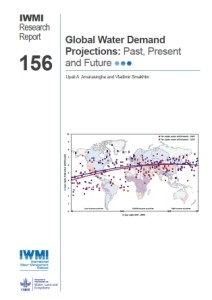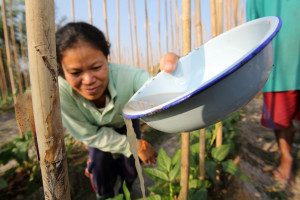By Jeff Smith
Pre-1990 global water demand projections dramatically over-estimated demand, while more recent models are underestimating water use, according to a new report published by the International Water Management Institute (IWMI).
Post-1990 projections have been especially over-optimistic about how much water can be saved through increases in efficiency in the developing world.
According to researchers, given current water-use trends, it is difficult to see how demand will decrease enough to meet sustainable water goals. The findings point to the need for better knowledge and projections at the local level.
“In order to reach some of these scenarios, we need drastic changes in water-use patterns,” said Upali Amarasinghe, a senior researcher at IWMI and lead author of the new report, Global water demand projections: Past, present and future.
The research study compared 13 global water demand projections with actual water withdrawals in 1995 and 2005 and estimated withdrawals for 2000 and 2010 in the domestic, industrial and agriculture sectors.
For example, the post-1990 models have underestimated water withdrawals in India by 3 to 14%. Globally, total domestic water use already exceeds the forecasts for 2025, and water demand for irrigation is much higher than expected. The projections were also off in the other direction too: Post-1990 models have over-estimated China’s water demand by 7 to 11%.
“Such exercises are useful in hindsight to see how correct the projections turned out to be, and the lessons that can be learned for making future projections,” said Vladimir Smakhtin, Leader of IWMI’s research theme on Water Availability, Risk and Resilience.
According to IWMI researchers, more accurate projections can help target investments that optimize water resources development, alleviate water-related conflicts, reduce environmental impacts, and aid in climate change adaptation. One of the big problems of global water demand projections is that they lack the local, river basin or country-level details that are needed.
“They are good for raising issues, but not good for planning,” said Amarasinghe. “The global studies may not have sufficient details or analysis to understand intra-country variations of key demand and supply factors. Projections made over a shorter time frame – 5 to 10 years – can also help local- and country-level planners come closer to on-the-ground realities.”
The flaws of the pre-1990 projections, which over-estimated water use by 20 to 130%, were attributed to unrealistic assumptions about water use in different sectors. However, what accounted for the discrepancies in the post-1990 projections, which used more sophisticated models?
According to Amarasinghe, researchers may have over-adjusted the projections. Also, it’s unclear how many different factors were considered in the global water demand models.
 IWMI’s research identified which drivers contribute the most to projections and should hence be given more consideration. For the post-1990 projections, for example, population growth is the main driver, but what is also needed is a good handle on economic development, water, land-use and cropping patterns, irrigation efficiencies and climate trends.
IWMI’s research identified which drivers contribute the most to projections and should hence be given more consideration. For the post-1990 projections, for example, population growth is the main driver, but what is also needed is a good handle on economic development, water, land-use and cropping patterns, irrigation efficiencies and climate trends.
For example, some global water forecasts have projected as much as a 13% decline in per capita irrigation demand. While high-income countries have almost achieved that (12%), the overall actual per capita withdrawals in the agriculture sector decreased by only 3% between 1995 and 2005.
This means that low-income countries, where agriculture is an even more important part of the economy, are still struggling to achieve gains in irrigation efficiency – important information for water resource planners.
IWMI researchers stressed that the agriculture sector is the most complex in which to make water demand projections. This is because so many factors weigh in: national self-sufficiency goals, economic growth, food security, cropping patterns, floods or droughts, soil fertility, access to water, water management technologies, etc.
The projections made for the domestic sector were even further off. Post-1990 projections estimated substantially lower water demand while, in reality, the sector posted the highest growth in per capita water withdrawals (26% between 1995 and 2005). However, this sector only accounts for 12% of global water withdrawals.
According to Amarasinghe, future studies should identify countries according to the present level of development, determine which drivers of change in water use are most important, and develop realistic national and sub-national scenarios for areas that are ready to move toward sustainable development.
Amarasinghe, U.A.; Smakhtin, V. 2014. Global water demand projections: Past, present and future. Colombo, Sri Lanka: International Water Management Institute (IWMI). 32p. (IWMI Research Report 156).
Upali Amarasinghe is a Senior Researcher at the International Water Management Institute (IWMI), Hyderabad, India.
Vladimir Smakhtin is Theme Leader – Water Availability, Risk and Resilience at IWMI, Colombo, Sri Lanka.


